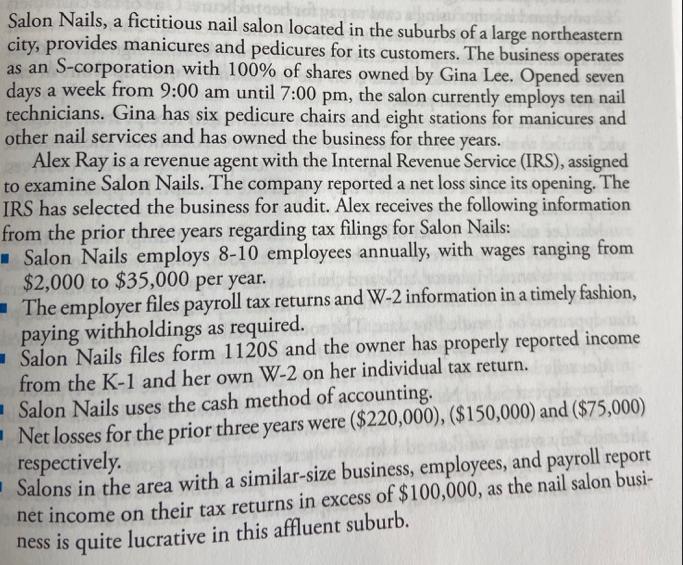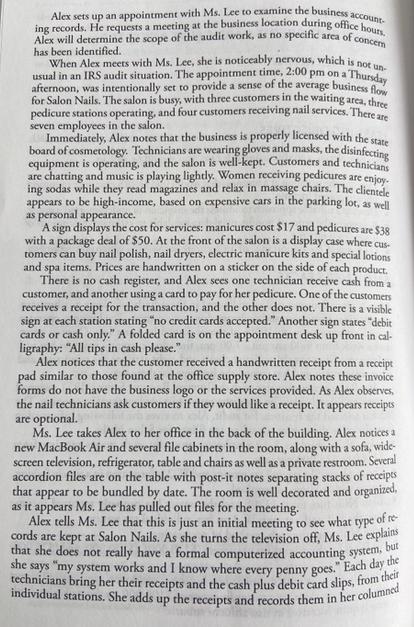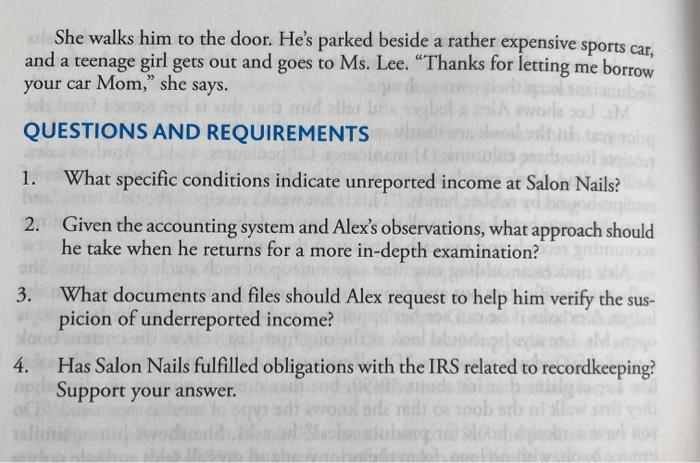Answered step by step
Verified Expert Solution
Question
1 Approved Answer
Salon Nails, a fictitious nail salon located in the suburbs of a large northeastern city, provides manicures and pedicures for its customers. The business




Salon Nails, a fictitious nail salon located in the suburbs of a large northeastern city, provides manicures and pedicures for its customers. The business operates as an S-corporation with 100% of shares owned by Gina Lee. Opened seven days a week from 9:00 am until 7:00 pm, the salon currently employs ten nail technicians. Gina has six pedicure chairs and eight stations for manicures and other nail services and has owned the business for three years. Alex Ray is a revenue agent with the Internal Revenue Service (IRS), assigned to examine Salon Nails. The company reported a net loss since its opening. The IRS has selected the business for audit. Alex receives the following information from the prior three years regarding tax filings for Salon Nails: Salon Nails employs 8-10 employees annually, with wages ranging from $2,000 to $35,000 per year. The employer files payroll tax returns and W-2 information in a timely fashion, paying withholdings as required. Salon Nails files form 1120S and the owner has properly reported income from the K-1 and her own W-2 on her individual tax return. Salon Nails uses the cash method of accounting. Net losses for the prior three years were ($220,000), ($150,000) and ($75,000) respectively. Salons in the area with a similar-size business, employees, and payroll report net income on their tax returns in excess of $100,000, as the nail salon busi- ness is quite lucrative in this affluent suburb. has been identified.. Alex sets up an appointment with Ms. Lee to examine the business account- Alex will determine the scope of the audit work, as no specific area of concer ing records. He requests a meeting at the business location during office hours, When Alex meets with Ms. Lee, she is noticeably nervous, which is not un- usual in an IRS audit situation. The appointment time, 2:00 pm on a Thursday afternoon, was intentionally set to provide a sense of the average business flow for Salon Nails. The salon is busy, with three customers in the waiting area, three pedicure stations operating, and four customers receiving nail services. There are seven employees in the salon.. Immediately, Alex notes that the business is properly licensed with the state board of cosmetology. Technicians are wearing gloves and masks, the disinfecting equipment is operating, and the salon is well-kept. Customers and technicians are chatting and music is playing lightly. Women receiving pedicures are enjoy ing sodas while they read magazines and relax in massage chairs. The clientele appears to be high-income, based on expensive cars in the parking lot, as well as personal appearance. A sign displays the cost for services: manicures cost $17 and pedicures are $38 with a package deal of $50. At the front of the salon is a display case where cus- tomers can buy nail polish, nail dryers, electric manicure kits and special lotions and spa items. Prices are handwritten on a sticker on the side of each product. There is no cash register, and Alex sees one technician receive cash from a customer, and another using a card to pay for her pedicure. One of the customers receives a receipt for the transaction, and the other does not. There is a visible sign at each station stating "no credit cards accepted." Another sign states "debit cards or cash only." A folded card is on the appointment desk up front in cal- ligraphy: "All tips in cash please." Alex notices that the customer received a handwritten receipt from a receipt pad similar to those found at the office supply store. Alex notes these invoice forms do not have the business logo or the services provided. As Alex observes, the nail technicians ask customers if they would like a receipt. It appears receipts are optional. Ms. Lee takes Alex to her office in the back of the building. Alex notices a new MacBook Air and several file cabinets in the room, along with a sofa, wide- screen television, refrigerator, table and chairs as well as a private restroom. Several accordion files are on the table with post-it notes separating stacks of receipts that appear to be bundled by date. The room is well decorated and organized, as it appears Ms. Lee has pulled out files for the meeting. Alex tells Ms. Lee that this is just an initial meeting to see what of re type cords are kept at Salon Nails. As she turns the television off, Ms. Lee explains that she does not really have a formal computerized accounting system, but she says "my system works and I know where every penny goes." Each day the technicians bring her their receipts and the cash plus debit card slips, from their individual stations. She adds up the receipts and records them in her columned ledger. After counting the cash and ensuring it matches the receipts, she deposits it in the bank or leaves it in the vault in the office until the next day's bank trip. Technicians keep their own cash tips. Ms. Lee shows Alex a ledger and tells him that this is her record from the prior year. In the book are neatly written penciled entries, separating the day's receipts into three columns: (1) manicures, (2) pedicures, and (3) product sales. As if reading Alex's mind, she opens a file cabinet where he notices stacks of receipts bound by rubber bands. "This is last week's receipts" she tells him, "and I can show you how I add up all these receipts and they total the amount in my accounting records and my cash deposits at the bank. Alex notices an adding machine tape on top of each stack of receipts. She pulls one specific date out and shows how the receipt matches her entry in the ledger. Alex asks if he can see her appointment book, but since the business is open, Ms. Lee says he should look at the one from last year, as the current book is needed for today's customers. "Do all customers make appointments?" he asks? Ms. Lee explains that it's about 50/50, but that most customers sign in when they first walk in the door so that she knows the type of service they need. "Do you have a receipt book for product sales?" he asks. She shows him a similar invoice book, with no logo, from the prior year and says all sales and sale tax are recorded accurately in the book. Moving on to deductions from the 1120S, Alex questions her regarding the expenses, and shows her the prior year's tax return. Payroll and payroll taxes, property taxes, sales tax and interest expense were all confirmed through the IRS electronic systems prior to the audit. Other expenses are listed in very broad cat- egories: Cost of Goods Sold, Office Supplies, Rent, Insurance, and "other." Ms. Lee shows him her payroll files, all kept in pencil in the same ledger as receipts. She explains that her nail technicians are straight salary, with no commission, ranging from $8 to $10 per hour, with a bonus paid each month based on pro- duction. "I give them cash bonuses, like the salon I used to work for did she explains. Ms. Lee pulls out her checkbook, business style, with three checks on a page. "It's all in here, and I add up my check stubs at the end of the year and use this to prepare my tax return. I bought the tax preparation software online and it works well. I run the business and manage the technicians so I can ensure our business is operated properly," she says. "May I see your receipts for other expenses?" Alex asks. Gina shows him her ledger entry which details each check in numerical order. "These checks match my receipts, which are in a box, by month, separated by type. I only write checks, as I know the IRS needs records" she replies. Again she opens a drawer that holds a similar accordion file, this one with a variety of receipts and computer print- outs. "I can show you how these receipts match the checks I write," she explains. Alex nods and tells Ms. Lee that he appreciates her information and that he'll be back next week with more specific questions. This is just a fact finding meeting, and since all files are manual, Alex has nothing to take with him. He thanks Ms. Lee for her time and says he will be in touch. She walks him to the door. He's parked beside a rather expensive sports car, and a teenage girl gets out and goes to Ms. Lee. "Thanks for letting me borrow your car Mom," she: says. bail ed a side er and eller works sou QUESTIONS AND REQUIREMENTS What specific conditions indicate unreported income at Salon Nails? 2. Given the accounting system and Alex's observations, what approach should he take when he returns for a more in-depth examination? sa bu 3. 4. What documents and files should Alex request to help him verify the sus- picion of underreported income? Kualarial Has Salon Nails fulfilled obligations with the IRS related to recordkeeping? Support your answer. faradskis saisigional d
Step by Step Solution
There are 3 Steps involved in it
Step: 1
1 The salon accepts only cash tips and employees are allowed to keep their own tips without reporting the tip amount to Ms Lee This means that the salon may not be reporting all of its income to the I...
Get Instant Access to Expert-Tailored Solutions
See step-by-step solutions with expert insights and AI powered tools for academic success
Step: 2

Step: 3

Ace Your Homework with AI
Get the answers you need in no time with our AI-driven, step-by-step assistance
Get Started


